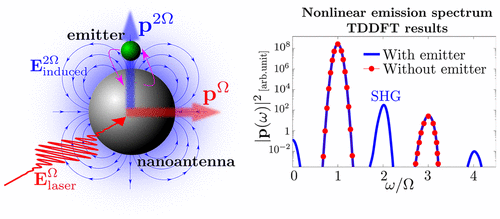当前位置:
X-MOL 学术
›
ACS Photonics
›
论文详情
Our official English website, www.x-mol.net, welcomes your
feedback! (Note: you will need to create a separate account there.)
Second-Harmonic Generation from a Quantum Emitter Coupled to a Metallic Nanoantenna
ACS Photonics ( IF 6.5 ) Pub Date : 2020-03-09 , DOI: 10.1021/acsphotonics.9b01569 Antton Babaze 1, 2 , Ruben Esteban 2, 3 , Javier Aizpurua 1, 2 , Andrei G. Borisov 4
ACS Photonics ( IF 6.5 ) Pub Date : 2020-03-09 , DOI: 10.1021/acsphotonics.9b01569 Antton Babaze 1, 2 , Ruben Esteban 2, 3 , Javier Aizpurua 1, 2 , Andrei G. Borisov 4
Affiliation

|
We use time-dependent density functional theory and a semiclassical model to study second-harmonic generation in a system comprising a quantum emitter and a spherical metallic nanoparticle, where the transition frequency of the quantum emitter is set to be resonant with the second harmonic of the incident frequency. The quantum emitter is shown to enable strong second-harmonic generation, which is otherwise forbidden because of symmetry constraints. The time-dependent density functional theory calculations allow one to identify the main mechanism driving this nonlinear effect, where the quantum emitter plays the role of an optical resonator that experiences the nonlinear near fields generated by the metallic nanoantenna located nearby. The influence of the intrinsic properties of the quantum emitter and the nanoantenna, together with the relative position of both in the coupled system, allows for a high degree of control of the nonlinear light emission. The main effects and contributions to this nonlinear process can be correctly captured by a semiclassical description developed in this work.
中文翻译:

耦合金属量子天线的量子发射器产生二次谐波
我们使用时变密度泛函理论和半经典模型来研究包含量子发射器和球形金属纳米粒子的系统中的二次谐波产生,其中量子发射器的跃迁频率设置为与原子的二次谐波共振。入射频率。示出了量子发射器能够实现强的二次谐波产生,否则由于对称约束而被禁止。随时间变化的密度泛函理论计算使人们能够确定驱动这种非线性效应的主要机制,其中量子发射器扮演着光谐振器的角色,该谐振器会受到附近金属纳米天线产生的非线性近场的影响。量子发射器和纳米天线的固有特性的影响,与两者在耦合系统中的相对位置一起,可以对非线性发光进行高度控制。可以通过在这项工作中开发的半经典描述正确地捕获对这种非线性过程的主要影响和贡献。
更新日期:2020-03-09
中文翻译:

耦合金属量子天线的量子发射器产生二次谐波
我们使用时变密度泛函理论和半经典模型来研究包含量子发射器和球形金属纳米粒子的系统中的二次谐波产生,其中量子发射器的跃迁频率设置为与原子的二次谐波共振。入射频率。示出了量子发射器能够实现强的二次谐波产生,否则由于对称约束而被禁止。随时间变化的密度泛函理论计算使人们能够确定驱动这种非线性效应的主要机制,其中量子发射器扮演着光谐振器的角色,该谐振器会受到附近金属纳米天线产生的非线性近场的影响。量子发射器和纳米天线的固有特性的影响,与两者在耦合系统中的相对位置一起,可以对非线性发光进行高度控制。可以通过在这项工作中开发的半经典描述正确地捕获对这种非线性过程的主要影响和贡献。










































 京公网安备 11010802027423号
京公网安备 11010802027423号